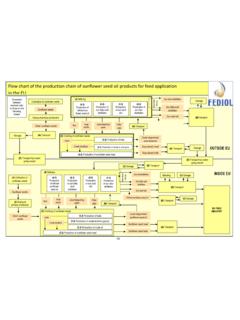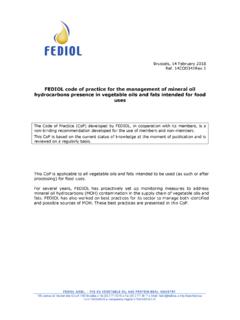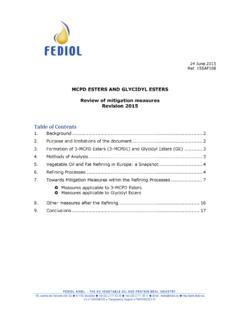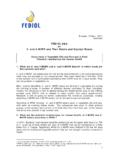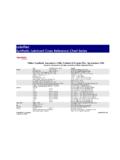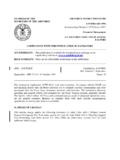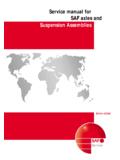Transcription of ESTABLISHING PROCESSING FACTORS FOR VEGETABLE OILS …
1 1 June, 2011 Ref. 11 SAF181 168, avenue de Tervuren (bte 12) B 1150 Bruxelles Tel (32) 2 771 53 30 Fax (32) 2 771 38 17 Email : ESTABLISHING PROCESSING FACTORS FOR VEGETABLE OILS AND FATS EU Regulation No. 396/2005 sets maximum residue levels (MRLs) for raw agricultural products, like oilseeds/oil fruits. MRLs for pesticides in processed products like crude oils (and refined oils) are not specifically set in EU legislation. According to Article 20 of Regulation No. 396/2005, MRLs for pesticides in processed products have to be derived from the MRLs for raw agricultural products, taking into account the concentration or dilution caused by PROCESSING ( PROCESSING factor).
2 In the oil extraction process, the concentration/dilution FACTORS depend on the type of PROCESSING and the extent to which meal and crude oil pick up a specific pesticide during crushing. The solubility of a pesticide in water or fat, and in the solvents used in oil extraction, influences the concentration of a pesticide in the processed products. For the reasons mentioned above, research is the only way to establish the PROCESSING FACTORS accurately. This would take a long time because there are more than 1000 pesticides and about 20 different types of crude oils that are of economic interest to the oil industry.
3 It is possible to estimate the maximum residue levels in crude oils based on the physico/chemical properties of the pesticides and on the oil content of the raw materials. Pesticides with high solubility in fat or in the extraction solvents may concentrate in crude oil. In this case the MRL for crude oil will be the seed MRL multiplied by a PROCESSING factor. This factor is inversely related to the oil content of the seed or lower. The possible concentration effects of PROCESSING should be taken into account also in the cases when the MRL is set at the limit of determination (LOD). The reason for this is that in some case, undetectable traces of a substance might be present in the seeds, and concentration during PROCESSING might lead to detection of a residue in the crude oil.
4 One of the criteria that can be used to predict the fate of a certain pesticide during oil extraction is its polarity. The octanol-water partition coefficient (log Pow) of a pesticide indicates whether a pesticide is water or fat-soluble. When a log Pow of a pesticide exceeds 3, the pesticide is considered fat-soluble1. 1 - OECD Guidance Document on Magnitude of Pesticide Residues in Processed Commodities. Series On Testing and Assessment, Number 96, July 2008 and - OECD Guidance Document on Testing of Chemicals, Magnitude of Pesticide Residues in Processed Commodities, Number 508, October 2008 - EU guidelines for the generation of residue data required under Dir 91/414/EC and Reg.
5 EC 396/2005 Appendix E on PROCESSING studies 1 June, 2011 11 SAF181 2 Another factor to be taken into account is the affinity of the substance for the extraction solvent2. In fact, some pesticides with a log Pow below 3, which are not expected to concentrate in the oil, can show the tendency to concentrate in the oil due to their solubility in solvents like hexane. Pesticides with a significant solubility in organic solvents as compared to water will follow the fat phase. For pesticides, where this solubility is close to the one of water, the behaviour of these specific pesticides will have to be analysed on a case-by-case basis.
6 Table 1 gives some PROCESSING FACTORS from seed/fruit to crude oil during solvent extraction to be applied for fat/hexane soluble pesticides. Table 1*: PROCESSING FACTORS to be applied for fat/hexane soluble pesticides Oil seed Average oil percentage PROCESSING factor Rapeseed 40-45 2,5 Sunflower seed 40-45 2,5 Soybean 18-21 5 Coconut (as it is for fruit incl. coconut water) 20 5 Palm fruit 50-55 2 Palm kernel 45 2 Groundnut/peanut 40-50 2,5 Linseed 40-50 2,5 *the content of this table will be updated as new information/data becomes available The EU pesticide database indicates which pesticides are fat soluble (by putting (F) behind the particular pesticide).
7 It should be noted that this information only provides general guidance, which cannot be regarded as conclusive for some particular pesticides, some pesticides that are not identified as fat soluble do behave as such. In-house data are decisive in such cases. * * * 2 Eg. Link to reference where solubility in solvents can be found.
